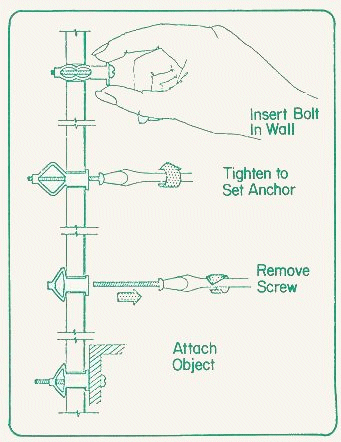I agree 100% with Travelover that it's better to drill into the mortar between the stones than it is to drill into the stone itself. And I agree with the reason; you can alway fix the hole in the mortar with new mortar, but fixing a hole in the stone or brick or whatever is between the mortar joints is much more challenging.
But, I think Travelover might just be using the wrong terminology when he suggests using a "Molly" or "Moly bolt", as these are meant for hollow walls, like drywall walls, and I thought I would catch that slip before you buy some Moly bolts and wonder how they're going to work in stone or mortar.
Here is how a "Moly bolt" works:
Basically, you drill a hole in the drywall and then insert and tighten the Molly bolt. The correct size Molly bolt will have "legs" that bend so as to clamp onto 3/8 inch thick, 1/2 inch thick or 5/8 inch thick drywall. Once you tighten the molly bolt all the way down to "set" it, you then remove the screw and hang whatever you want on the wall using that same screw threaded into the Molly bolt.
Here's some Molly bolts:
I expect what Travelover meant to recommend was a plastic "anchor". Anchors come in different sizes and shapes, but the most common materials anchors are made from are plastic, lead and wood fiber. The procedure to install them is simple: You drill a hole in the mortar (typically 3/16 or 1/4 inch), remove the dust from the hole, tap in a plastic anchor, and then drive a screw into the soft plastic anchor. For a wreath, a 3/16 inch plastic anchor will offer more than sufficient holding power, but no one is gonna bark at you for using a 1/4 inch plastic anchor if you want. As you drive the screw in, the anchor expands and presses tightly against the ID of the hole. So, plastic anchors are pretty well useless in drywall because the drywall crushes so easily. Plastic anchors work much better in plaster or mortar which can withstand the expansive force with which the plastic anchor grips the ID of the hole it's in.
Here's some typical anchors:
The one on the top left is a lead anchor, and they're generally used in masonary walls for the greatest holding power, and for use with larger screws like #12 and #14 screw sizes. The most common style of nylon plastic anchor is the yellow one on the far right, and they come in different sizes. Where I live, the yellow ones require that you drill a 3/16 inch diameter hole; the blue ones need a 1/4 inch size hole, and the green ones fit into a 5/16 inch diameter hole, but I don't know if that colour code is followed by all manufacturers. The 3/16 inch size anchors will take a #8 screw, the 1/4 inch anchors will take a #10 screw and the 5/16 anchors will take a #12 screw.
You'll find that it can be hard to drive plastic anchors into the correct hole size. I find that when I'm drilling into plaster, I first drill the correct size hole with a masonary bit, and then I use a 1/64 inch oversize ordinary twist drill bit to enlarge the hole 1/64th" to make it easier to insert the anchors. (I have a cheap 13/64 and a cheap 17/64 inch drill bits I use just for enlarging 3/16" and 1/4" holes in plaster walls for plastic anchors.)
Finally, when installing an anchor in a brick or block wall, people will sometimes recommend installing the anchor into a HORIZONTAL mortar joint rather than a vertical one. The reason why is that if you ever watch a mason lay a brick wall, he'll put the bed of mortar down first, and then slap a bit of mortar on the end of each brick before laying it into the mortar bed. So, the horizontal mortar joints will be the full thickness of the brick, but the vertical mortar joints won't be. The vertical mortar joints will only be about 1/2 to 3/4 of the thickness of the brick at most, and often less. But, that's OK cuz the vertical mortar joints don't support anything; the bricks and horizontal joints carry all the weight. The vertical joints are just there to keep rain water out of the wall. But, truth is that plastic anchors won't be any longer than half the thickness of a brick at most anyhow, so in most cases anchoring into a vertical vertical mortar joint will be just as strong as anchoring into a horizontal one.







